Research on the Thermal Hydraulic Performance and Entropy Generation Characteristics of Finned Tube Heat Exchanger with Streamline Tube
Abstract
Highlights
- Flow characteristics in the windward region and wake region flow characteristics were investigated.
- By decreasing wake region, the flow characteristic was improved and the overall performance was enhanced.
- The k-ε-enhance model was employed to numerically investigate the overall performance.
1. Introduction
2. Model Description
2.1. Physical Model
2.2. Governing Equations
- (1)
- A steady state was assumed;
- (2)
- The flow was three-dimensional and incompressible;
- (3)
- The working fluid was in a single phase, and their properties kept constant;
- (4)
- Effects of heat dissipation and thermal radiation were negligible;
2.3. Boundary Conditions
- (1)
- Boundary conditions of inlet part were described as follows [4].At inlet boundary condition:At side boundary conditions:At the top and bottom boundaries (periodic conditions):
- (2)
- The boundary conditions of outlet part were described as follows.At outlet boundary condition:At side boundary conditions:At the top and bottom boundaries (periodic conditions):
- (3)
- The boundary conditions of Fin-coil part are described as follows.At side boundary condition:At the top and bottom boundaries (periodic conditions):
3. Model Verification
3.1. Parameter Definition
- (1)
- Friction factor f represented the friction characteristic, defined as follows.
- (2)
- Colburn factor j represented the heat transfer capability, defined as follows.
- (3)
- In order to evaluate the overall performance of the tube-and-fin heat exchanger, the performance evaluation is used to evaluate the thermal performance, suggested by Webb [32], defined in terms of Colburn factor and Friction factor as follows.
3.2. Entropy Generation Analysis
3.3. Mesh Generation Technique
3.4. Code Validation
4. Results and Discussion
4.1. Discussion of the Effect of Geometrical Parameters
4.1.1. The Effect of Transversal Tube Pitch
4.1.2. The Effect of Longitudinal Tube Pitch
4.1.3. The Effect of Angle
4.2. Analysis on the Thermal Hydraulic Performance
4.2.1. Analysis on the Flow Characteristics and Thermal Performance
4.2.2. Analysis on Turbulence Kinetic Energy
4.2.3. Analysis on the Entropy Generation
5. Conclusions
Author Contributions
Funding
Conflicts of Interest
Nomenclature
| The total area of heat transfer () | |
| The wetted surface area () | |
| The Bejan number () | |
| () | |
| The heat capacity of working fluid () | |
| The perimeter of the heat transfer section () | |
| The hydraulic diameter () | |
| Fin pitch () | |
| Fin thickness () | |
| The friction factor ( | |
| () | |
| The turbulence intensity () | |
| The Colburn factor () | |
| k | Turbulent kinetic energy () |
| () | |
| The length of flow direction () | |
| Longitudinal tube pitch () | |
| Transverse tube pitch () | |
| The mass flow of working fluid () | |
| The Nusselt number () | |
| P | () |
| () | |
| The total rate of heat transfer () | |
| The Reynolds number () | |
| The large radius of the heat transfer tube () | |
| The small radius of the heat transfer tube () | |
| The local thermal entropy generation rate | |
| The local frictional entropy generation rate | |
| The local volumetric entropy generations rate | |
| The temperature of the outlet () | |
| The temperature of the inlet () | |
| The temperature of wall () | |
| Temperature of the working fluid () | |
| u | () |
| () | |
| Volume of working fluid () | |
Greek Symbols
| The pressure drop between the inlet and outlet () | |
| () | |
| Dissipation rate of turbulent kinetic energy of the k- model () | |
| () | |
| () | |
| Dynamic viscosity () | |
| () | |
| Kinematic viscosity () | |
| Density of working fluid () | |
| () | |
| () | |
| The streamline () |
Subscripts
References
- He, Y.L.; Chu, P.; Tao, W.Q.; Zhang, Y.W.; Xie, T. Analysis of heat transfer and pressure drop for fin-and-tube heat exchangers with rectangular winget-type vortex generators. Appl. Therm. Eng. 2013, 61, 770–783. [Google Scholar] [CrossRef]
- Du, X.; Zeng, M.; Dong, Z.; Wang, Q. Experimental study of the effect of air inlet angle on the air-side performance for cross-flow finned oval-tube heat exchangers. Exp. Therm. Fluid Sci. 2014, 52, 146–155. [Google Scholar] [CrossRef]
- Gu, L.; Min, J.; Wu, X.; Yang, L. Airside heat transfer and pressure loss characteristics of bare and finned tube heat exchangers used for aero engine cooling considering variable air properties. Int. J. Heat Mass Transf. 2017, 108, 1839–1849. [Google Scholar] [CrossRef]
- Zeeshan, M.; Nath, S.; Bhanja, D. Numerical study to predict optimal configuration of fin and tube compact heat exchanger with various tube shapes and spatial arrangements. Energy Convers. Manag. 2017, 148, 737–752. [Google Scholar] [CrossRef]
- Yogesh, S.S.; Selvaraj, A.S.; Ravi, D.K.; Rajagopal, T.K.R. Heat transfer and pressure drop characteristics of inclined elliptical fin tube heat exchanger of varying ellipticity ratio using CFD code. Int. J. Heat Mass Transf. 2018, 119, 26–39. [Google Scholar] [CrossRef]
- Mohanty, R.L.; Swain, A.; Das, M.K. Thermal performance of mixed tube bundle composed of circular and elliptical tubes. Therm. Sci. Eng. Prog. 2018, 5, 492–505. [Google Scholar] [CrossRef]
- Taler, D.; Ocłoń, P. Determination of heat transfer formulas for gas flow in fin-and-tube heat exchanger with oval tubes using CFD simulations. Chem. Eng. Process. Process. Intensif. 2014, 83, 1–11. [Google Scholar] [CrossRef]
- Taler, D.; Ocłoń, P. Thermal contact resistance in plate fin-and-tube heat exchangers, determined by experimental data and CFD simulations. Int. J. Therm. Sci. 2014, 84, 309–322. [Google Scholar] [CrossRef]
- Park, D.H.; Lee, D.B.; Seo, E.R.; Park, Y.J. Study on the heat transfer and fluid flow characteristics in V-shaped corrugated composite fin. Appl. Therm. Eng. 2016, 102, 293–301. [Google Scholar] [CrossRef]
- Saviano, L.O.; Dezan, D.J.; Yanagihara, J.I. Thermal-hudralic performance optimization of inline and staggered fin-tube compact heat exchangers applying longitudinal vortex generators. Appl. Therm. Eng. 2016, 95, 311–329. [Google Scholar] [CrossRef]
- Li, J.; Wang, S.; Chen, J.; Lei, Y.-G. Numerical study on a slit fin-and-tube heat exchanger with longitudinal vortex generators. Int. J. Heat Mass Transf. 2011, 54, 1743–1751. [Google Scholar] [CrossRef]
- Sadeghianjahromi, A.; Kheradmand, S.; Nemati, H. Developed correlations for heat transfer and flow friction characteristics of louvered finned tube heat exchangers. Int. J. Therm. Sci. 2018, 129, 135–144. [Google Scholar] [CrossRef]
- Lotfi, B.; Sundén, B.; Wang, Q. An investigation of the thermo-hydraulic performance of the smooth wavy fin-and-elliptical tube heat exchangers utilizing new type vortex generators. Appl. Energy 2016, 162, 1282–1302. [Google Scholar] [CrossRef]
- Deepakkumar, R.; Jayavel, S. Air side performance of finned-tube heat exchanger with combination of circular and elliptical tubes. Appl. Therm. Eng. 2017, 119, 360–372. [Google Scholar] [CrossRef]
- Han, H.; He, Y.-L.; Li, Y.-S.; Wang, Y.; Wu, M. A numerical study on compact enhanced fin-and-tube heat exchangers with oval and circular tube configurations. Int. J. Heat Mass Transf. 2013, 65, 686–695. [Google Scholar] [CrossRef]
- Sun, L.; Zhang, C.-L. Evaluation of elliptical finned-tube heat exchanger performance using CFD and response surface methodology. Int. J. Therm. Sci. 2014, 75, 45–53. [Google Scholar] [CrossRef]
- Vaezi, S.; Karbalaee, S.; Hanafizadeh, P. Effect of aspect ratio on heat transfer enhancement in alternating oval double pipe heat exchangers. Appl. Therm. Eng. 2017, 125, 1164–1172. [Google Scholar] [CrossRef]
- Tala, J.S.; Bougeard, D.; Russeil, S.; Harion, J.-L. Tube pattern effect on thermalhydraulic characteristics in a two-rows finned-tube heat exchanger. Int. J. Therm. Sci. 2012, 60, 225–235. [Google Scholar] [CrossRef]
- Nayak, R.; Bhattacharyya, S.; Pop, I. Heat transfer and entropy generation in mixed convection of a nanofluid within an inclined skewed cavity. Int. J. Heat Mass Transf. 2016, 102, 596–609. [Google Scholar] [CrossRef]
- Torabi, M.; Torabi, M.; Ghiaasiaan, S.; Peterson, G. The effect of Al 2 O 3 -water nanofluid on the heat transfer and entropy generation of laminar forced convection through isotropic porous media. Int. J. Heat Mass Transf. 2017, 111, 804–816. [Google Scholar] [CrossRef]
- Ebrahimi, A.; Rikhtegar, F.; Sabaghan, A.; Roohi, E. Heat transfer and entropy generation in a microchannel with longitudinal vortex generators using nanofluids. Energy 2016, 101, 190–201. [Google Scholar] [CrossRef]
- Manay, E.; Akyürek, E.F.; Sahin, B. Entropy generation of nanofluid flow in a microchannel heat sink. Results Phys. 2018, 9, 615–624. [Google Scholar] [CrossRef]
- Esfahani, J.; Akbarzadeh, M.; Rashidi, S.; Rosen, M.; Ellahi, R. Influences of wavy wall and nanoparticles on entropy generation over heat exchanger plat. Int. J. Heat Mass Transf. 2017, 109, 1162–1171. [Google Scholar] [CrossRef]
- Akbarzadeh, M.; Rashidi, S.; Esfahani, J. Influences of corrugation profiles on entropy generation, heat transfer, pressure drop, and performance in a wavy channel. Appl. Therm. Eng. 2017, 116, 278–291. [Google Scholar] [CrossRef]
- Bhuiyan, A.A.; Amin, M.R.; Islam, A.S. Three-dimensional performance analysis of plain fin tube heat exchangers in transitional regime. Appl. Therm. Eng. 2013, 50, 445–454. [Google Scholar] [CrossRef]
- Kim, M.-S.; Lee, J.; Yook, S.-J.; Lee, K.-S. Correlations and optimization of a heat exchanger with offset-strip fins. Int. J. Heat Mass Transf. 2011, 54, 2073–2079. [Google Scholar] [CrossRef]
- Fluent, version 6.3; ANSYS Inc.: Southpointe, Canonsburg, PA, USA, 2009.
- Lu, C.-W.; Huang, J.-M.; Nien, W.; Wang, C.-C. A numerical investigation of the geometric effects on the performance of plate finned-tube heat exchanger. Energy Convers. Manag. 2011, 52, 1638–1643. [Google Scholar] [CrossRef]
- Ahsan, M. Numerical analysis of friction factor for a fully developed turbulent flow using k–ε turbulence model with enhanced wall treatment. Beni-Suef Univ. J. Basic Appl. Sci. 2014, 3, 269–277. [Google Scholar] [CrossRef]
- Ibrahim, T.A.; Gomaa, A. Thermal performance criteria of elliptic tube bundle in crossflow. Int. J. Therm. Sci. 2009, 48, 2148–2158. [Google Scholar] [CrossRef]
- Cheng, J.; Qian, Z.; Wang, Q. Analysis of heat transfer and flow resistance of twisted oval tube in low Reynolds number flow. Int. J. Heat Mass Transf. 2017, 109, 761–777. [Google Scholar] [CrossRef]
- Webb, R.L.; Kim, N.H. Principle of Enhanced Heat Transfer, 2nd ed.; Taylorand Francis Group: New York, NY, USA, 2005. [Google Scholar]
- Torabi, M.; Karimi, N.; Zhang, K. Heat transfer and second law analysis of forced convection in a channel partially filled by porous media and featuring internal heat sources. Energy 2015, 93, 106–127. [Google Scholar] [CrossRef]
- Bondareva, N.S.; Sheremet, M.A.; Oztop, H.F.; Abu-Hamdeh, N. Entropy generation due to natural convection of a nanofluid in a partially open triangular cavity. Adv. Powder Technol. 2017, 28, 244–255. [Google Scholar] [CrossRef]
- Wang, C.-C.; Chang, Y.-J.; Hsieh, Y.-C.; Lin, Y.-T. Sensible heat and friction characteristics of plate fin-and-tube heat exchangers having plane fins. Int. J. Refrig. 1996, 19, 223–230. [Google Scholar] [CrossRef]
- Qian, Z.; Wang, Q.; Cheng, J. Analysis of heat and resistance performance of plate fin-and-tube heat exchanger with rectangle-winglet vortex generator. Int. J. Heat Mass Transf. 2018, 124, 1198–1211. [Google Scholar] [CrossRef]
- Haseli, Y. Efficiency improvement of thermal power plants through specific entropy generation. Energy Convers. Manag. 2018, 159, 109–120. [Google Scholar] [CrossRef]
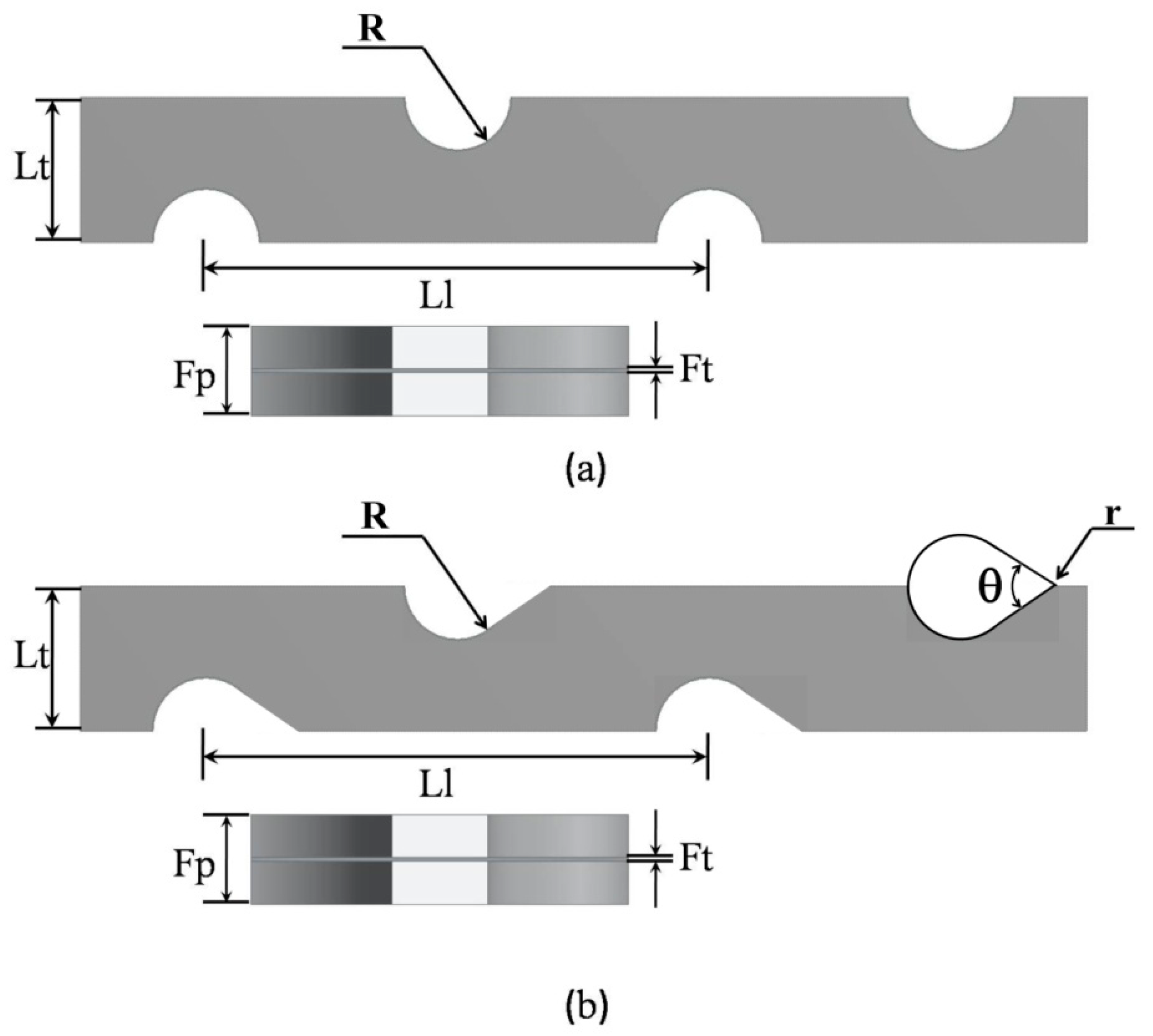
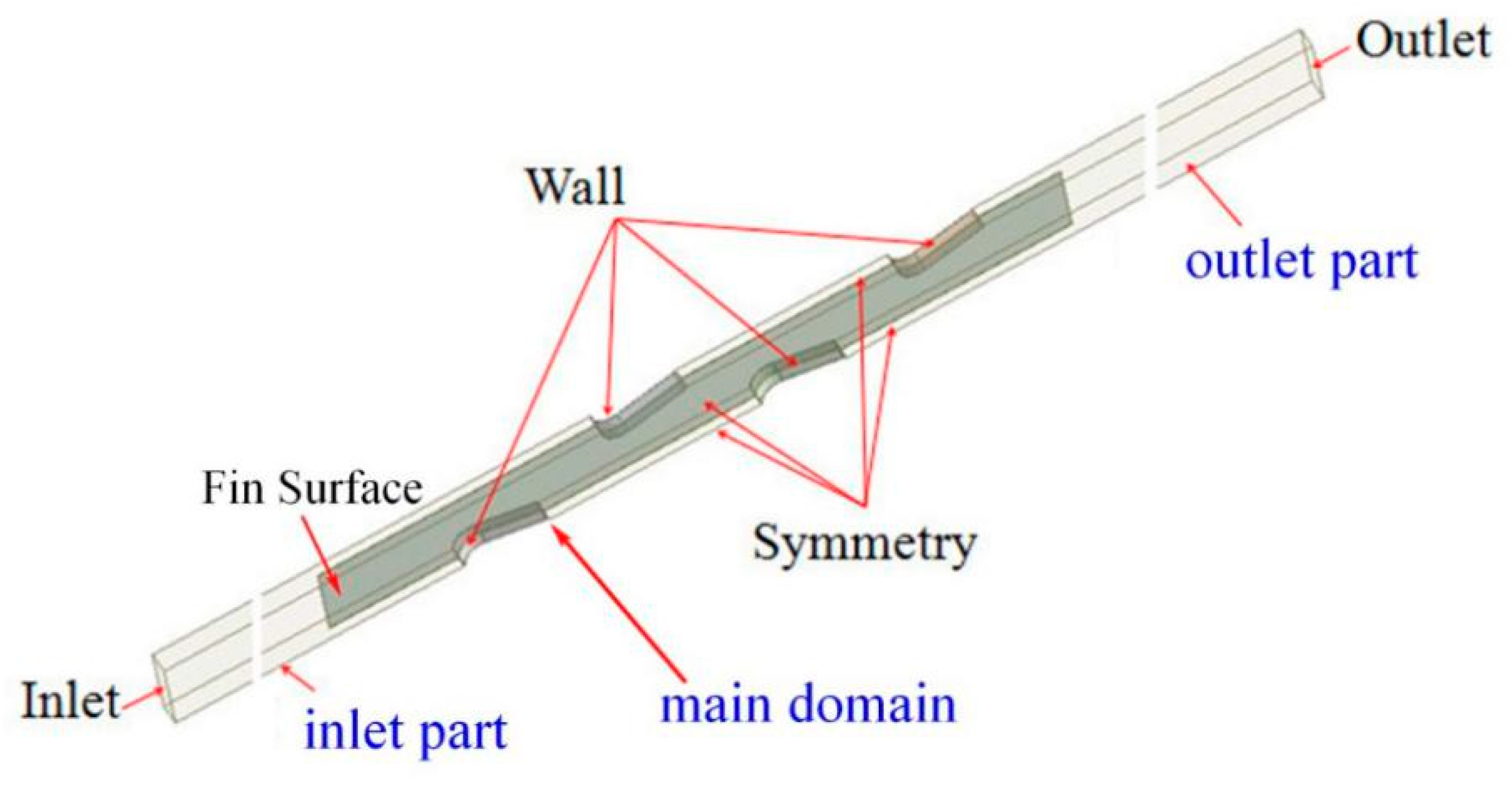
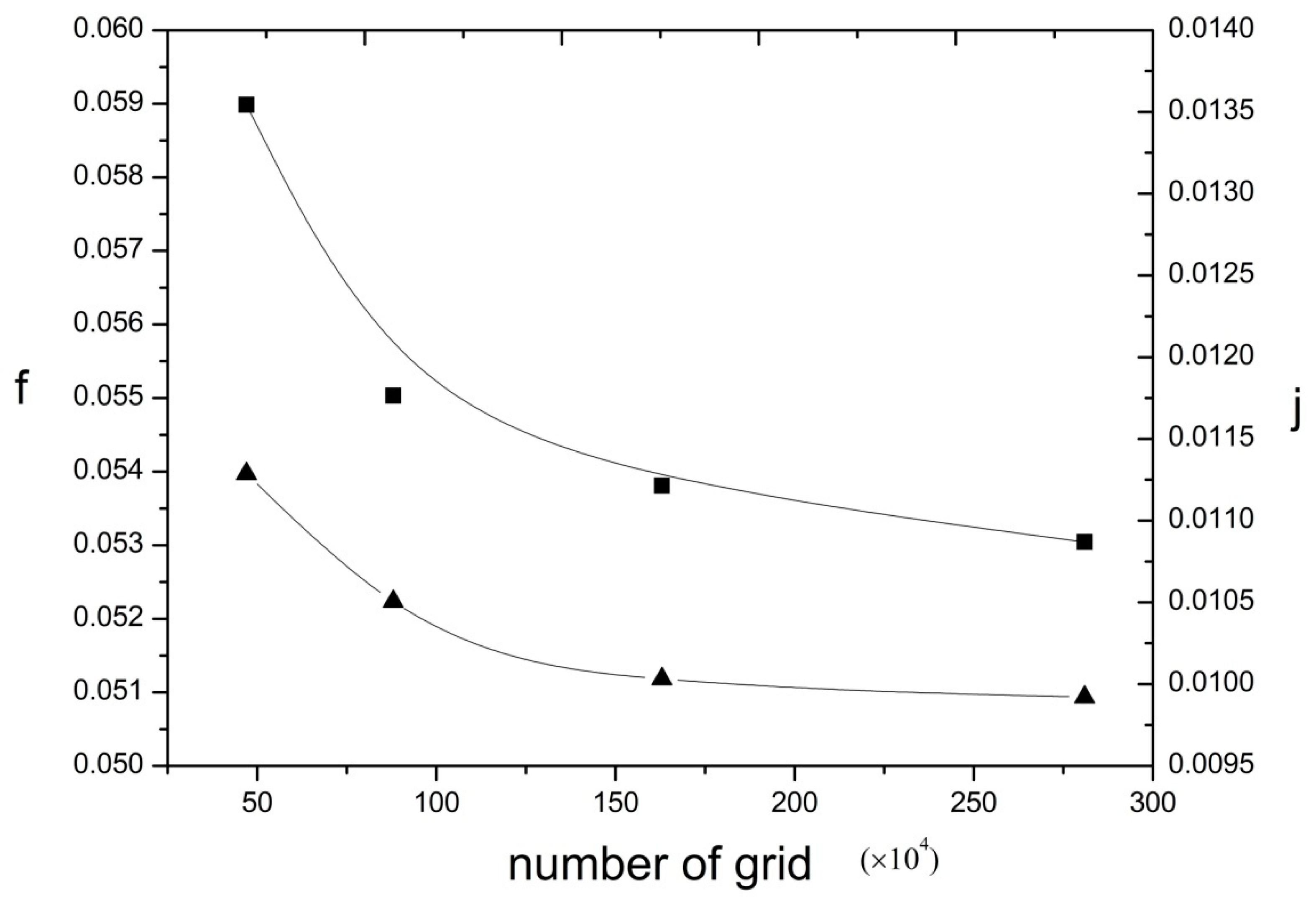
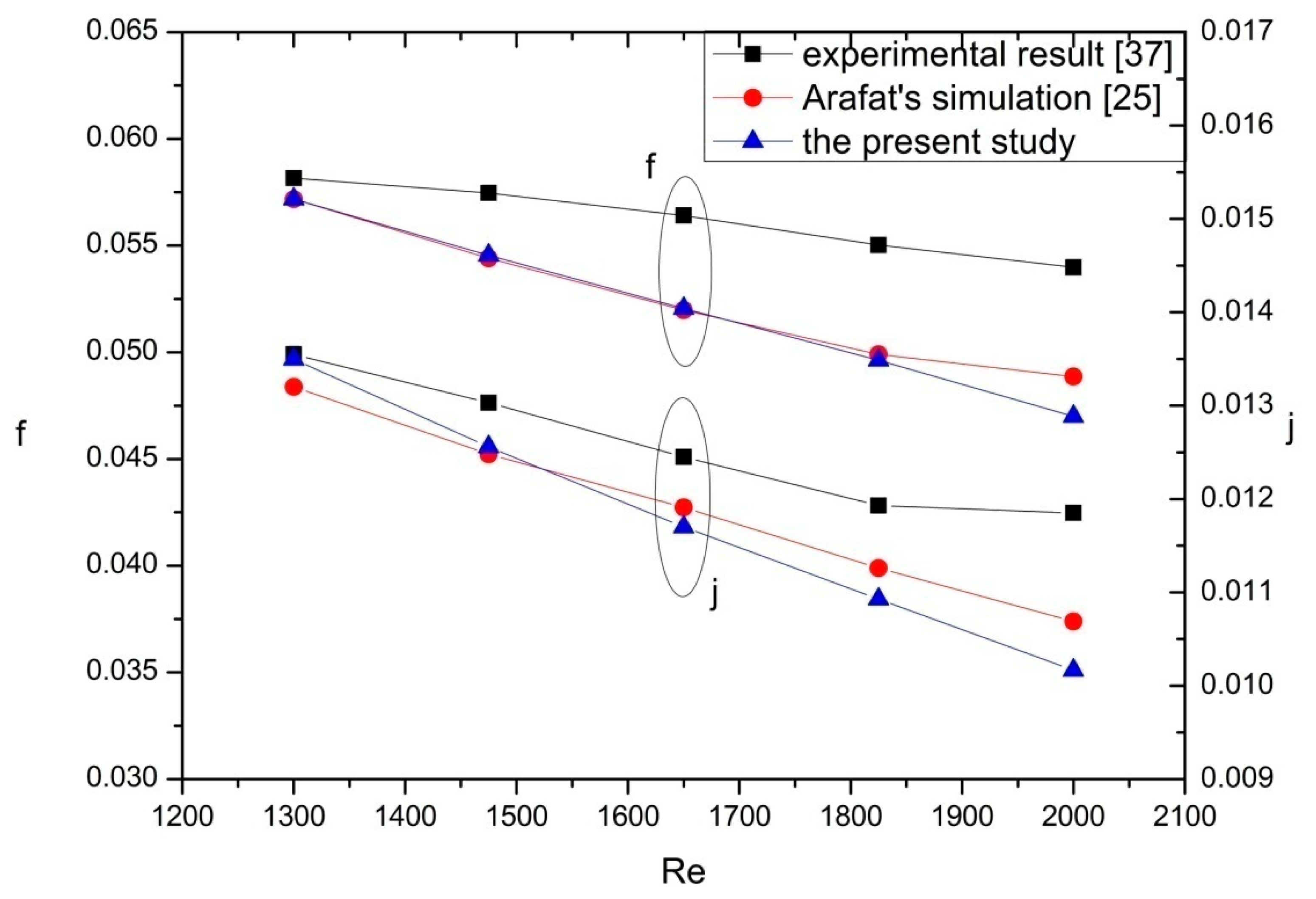
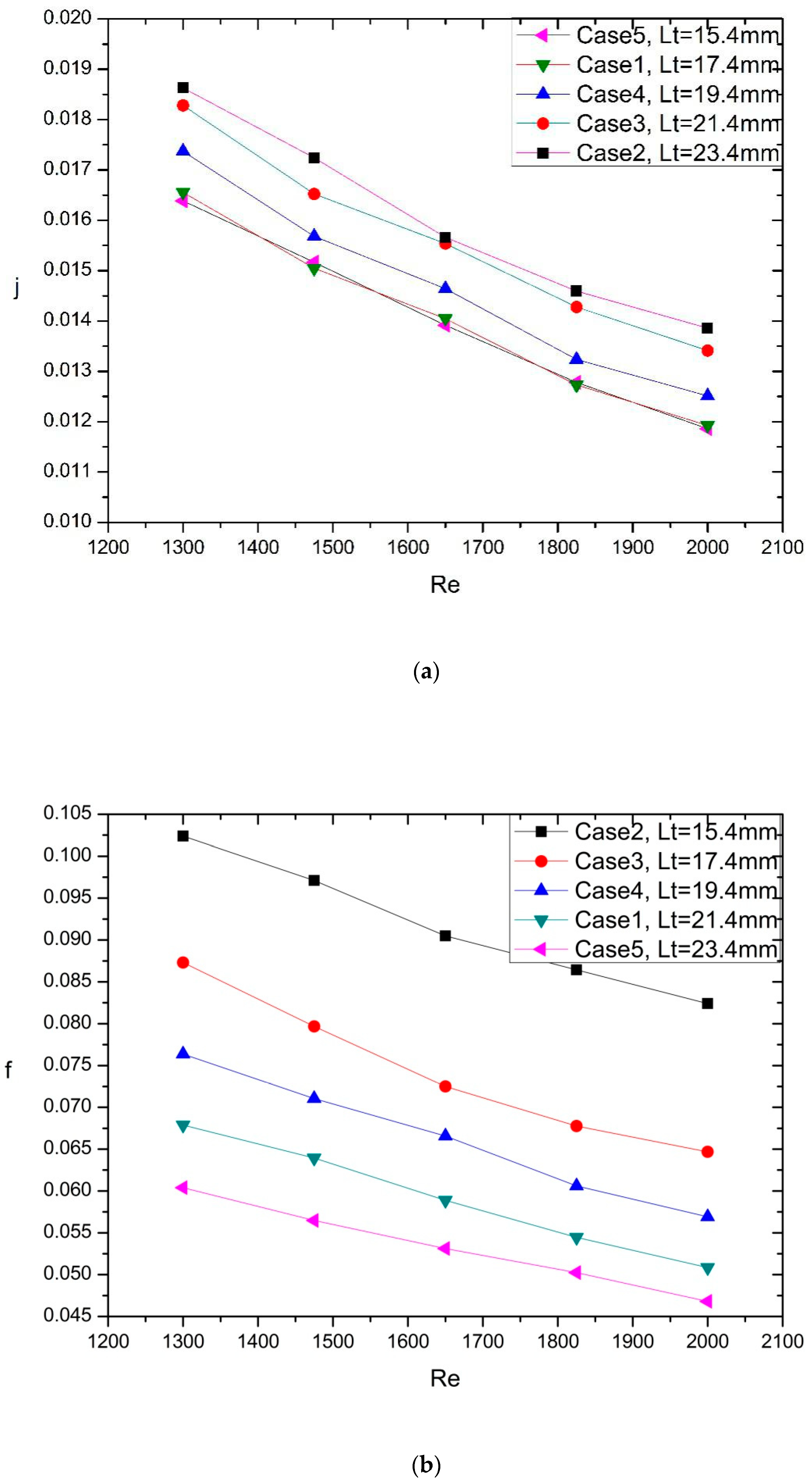
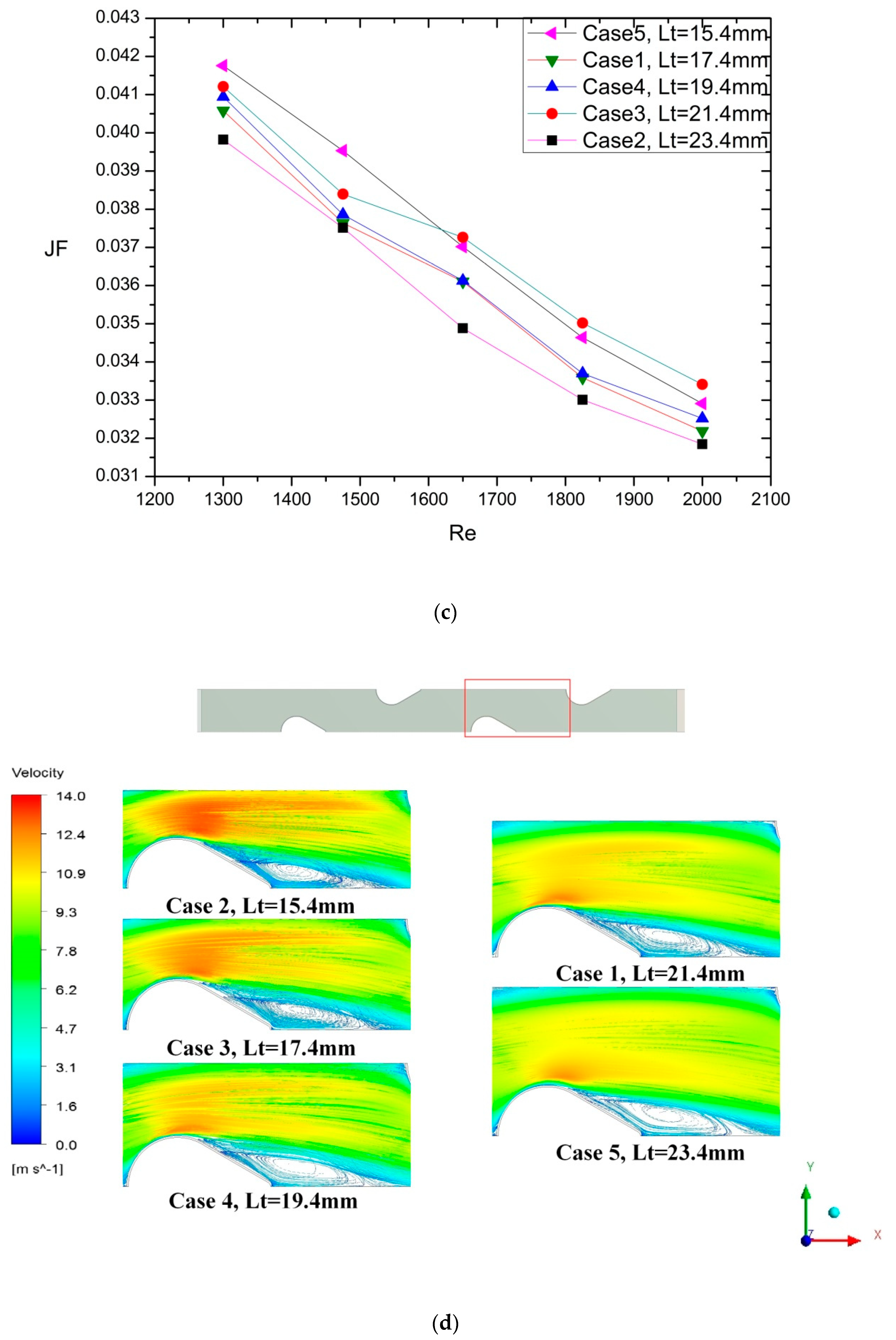
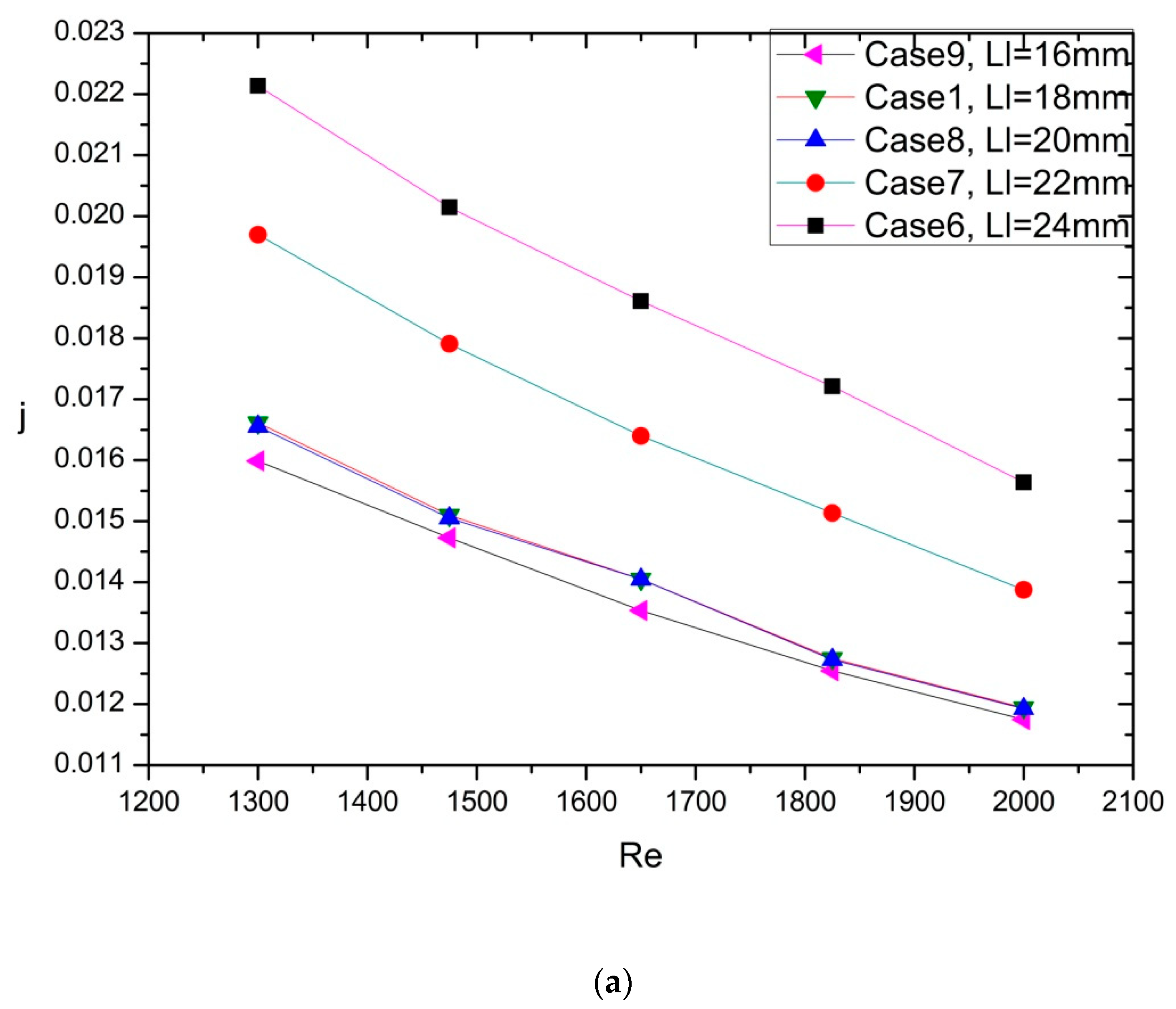
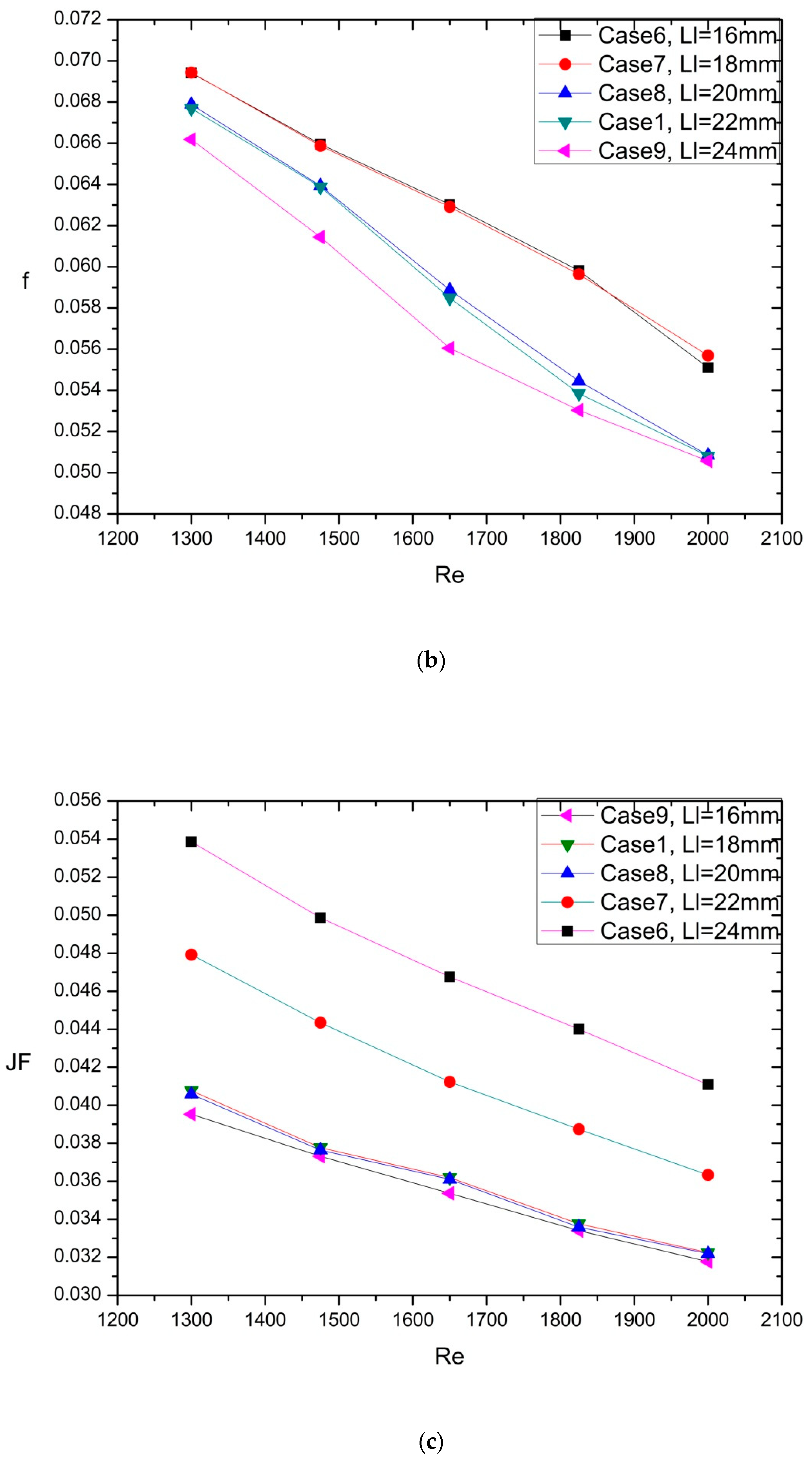
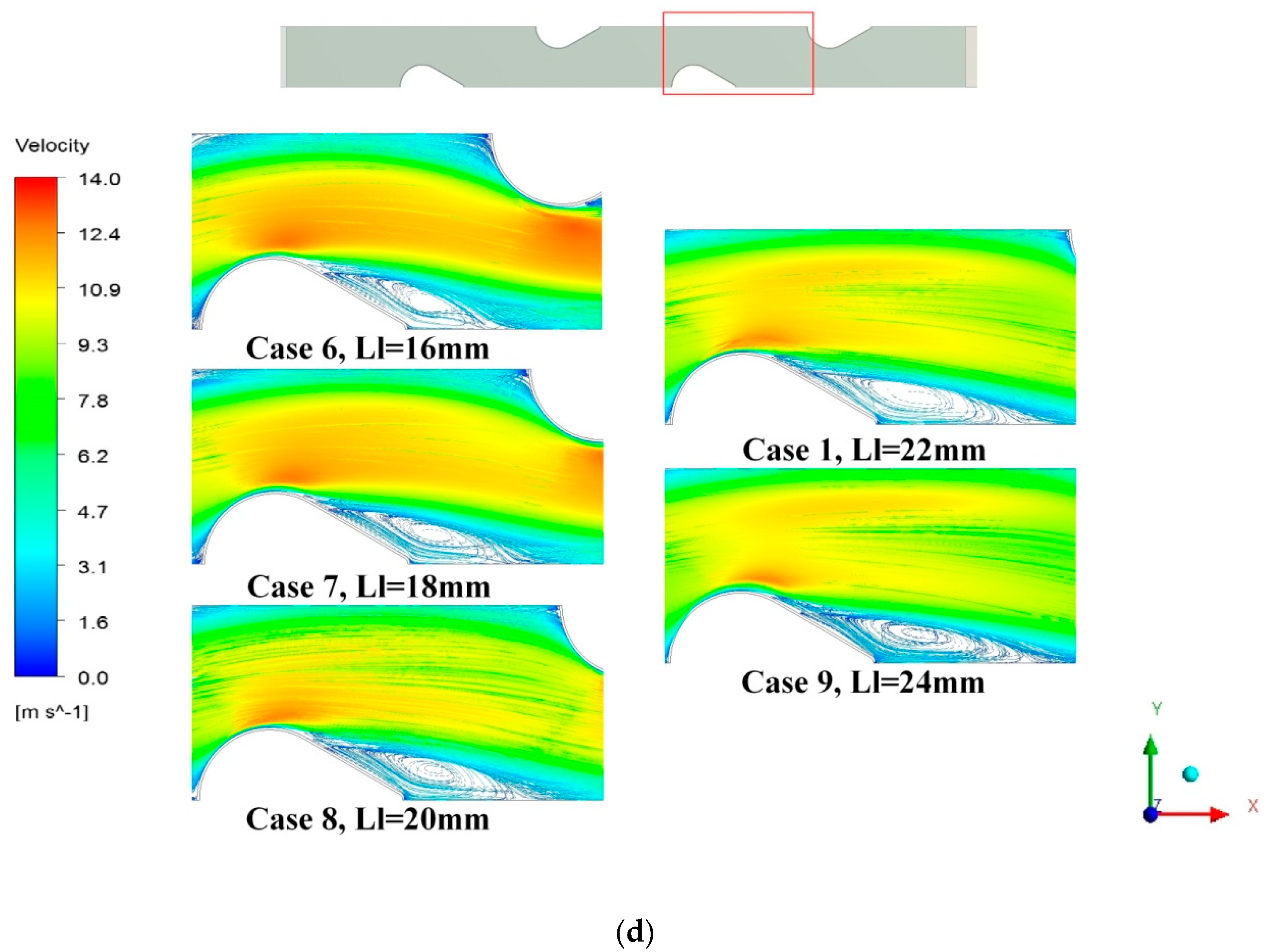
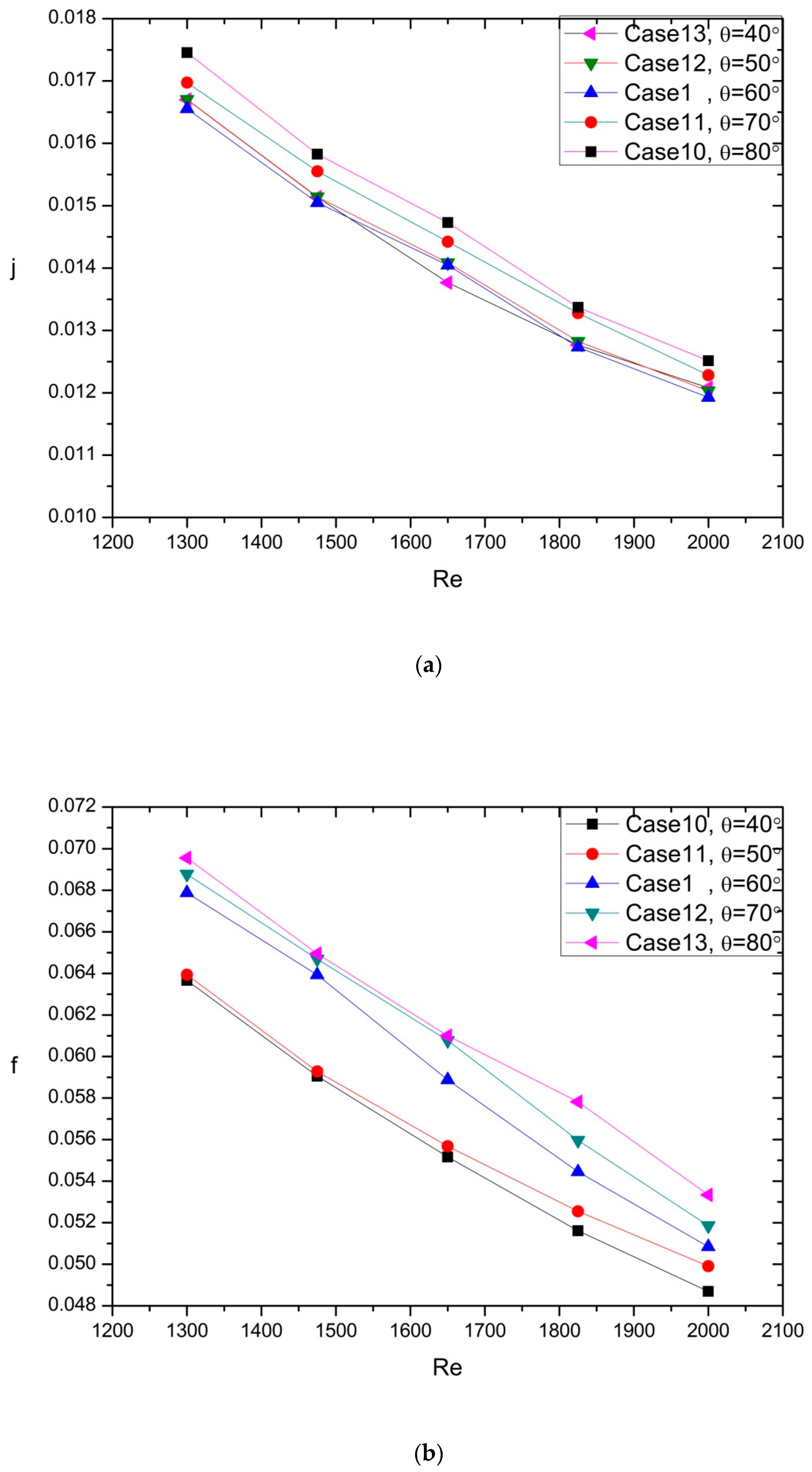
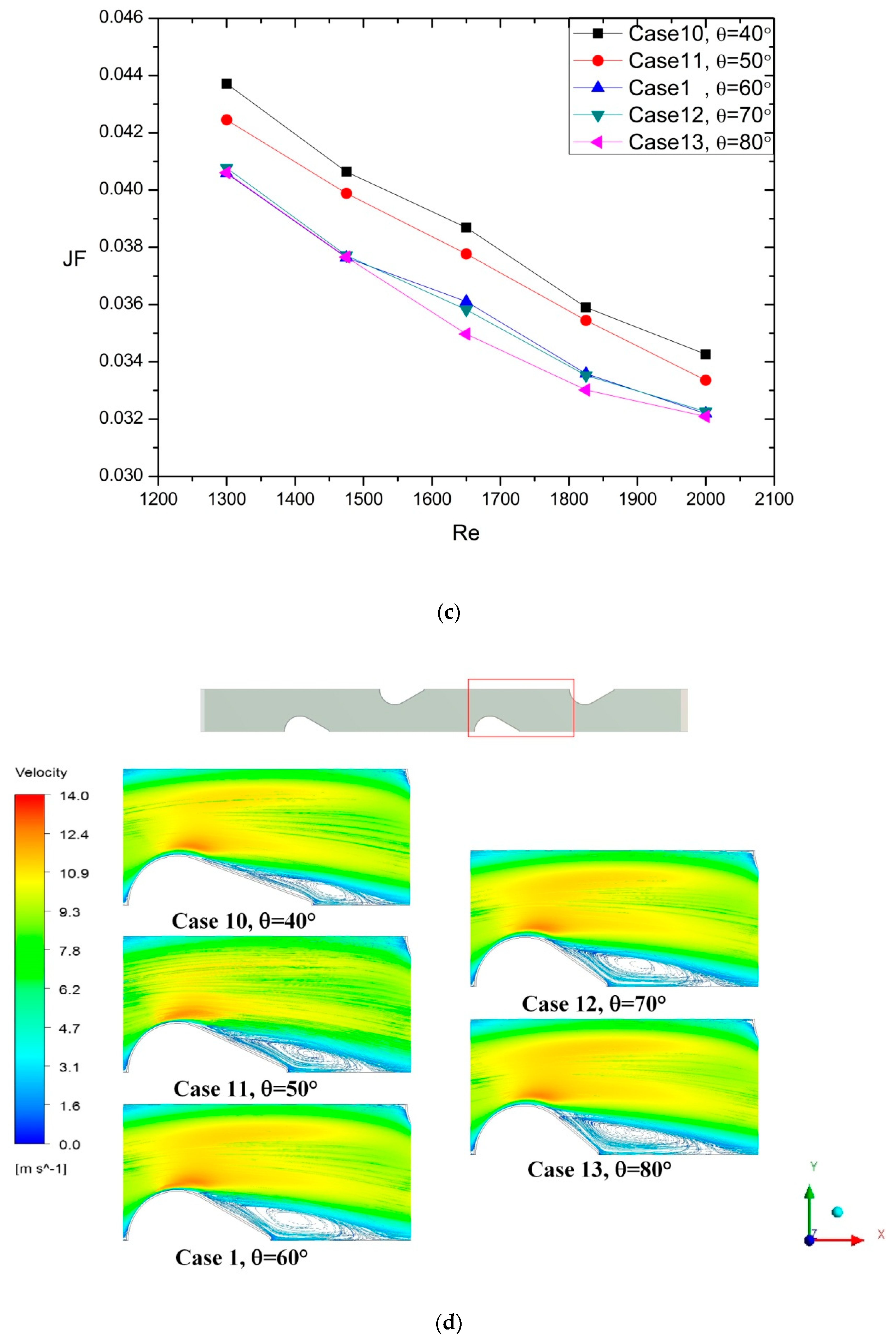
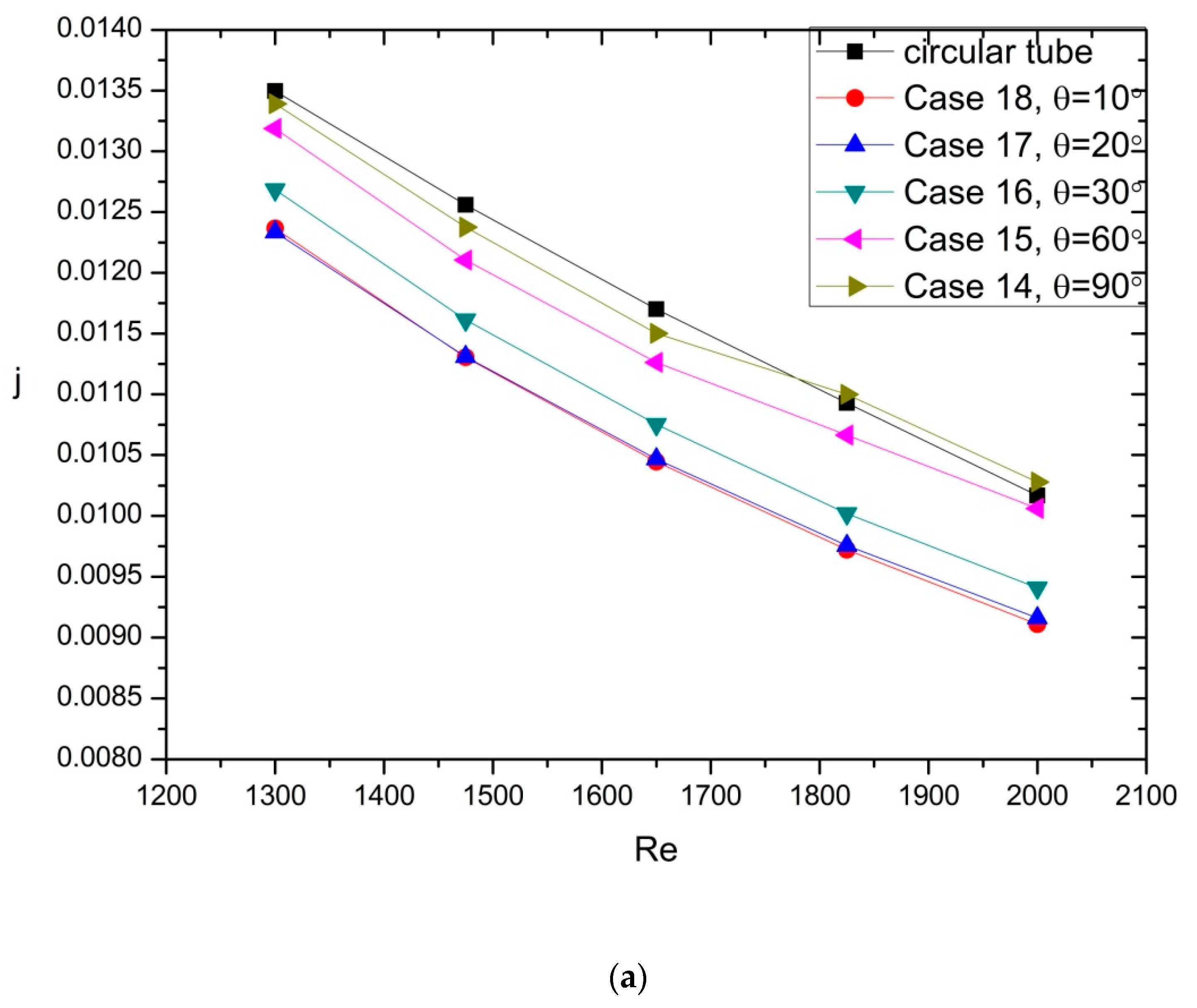
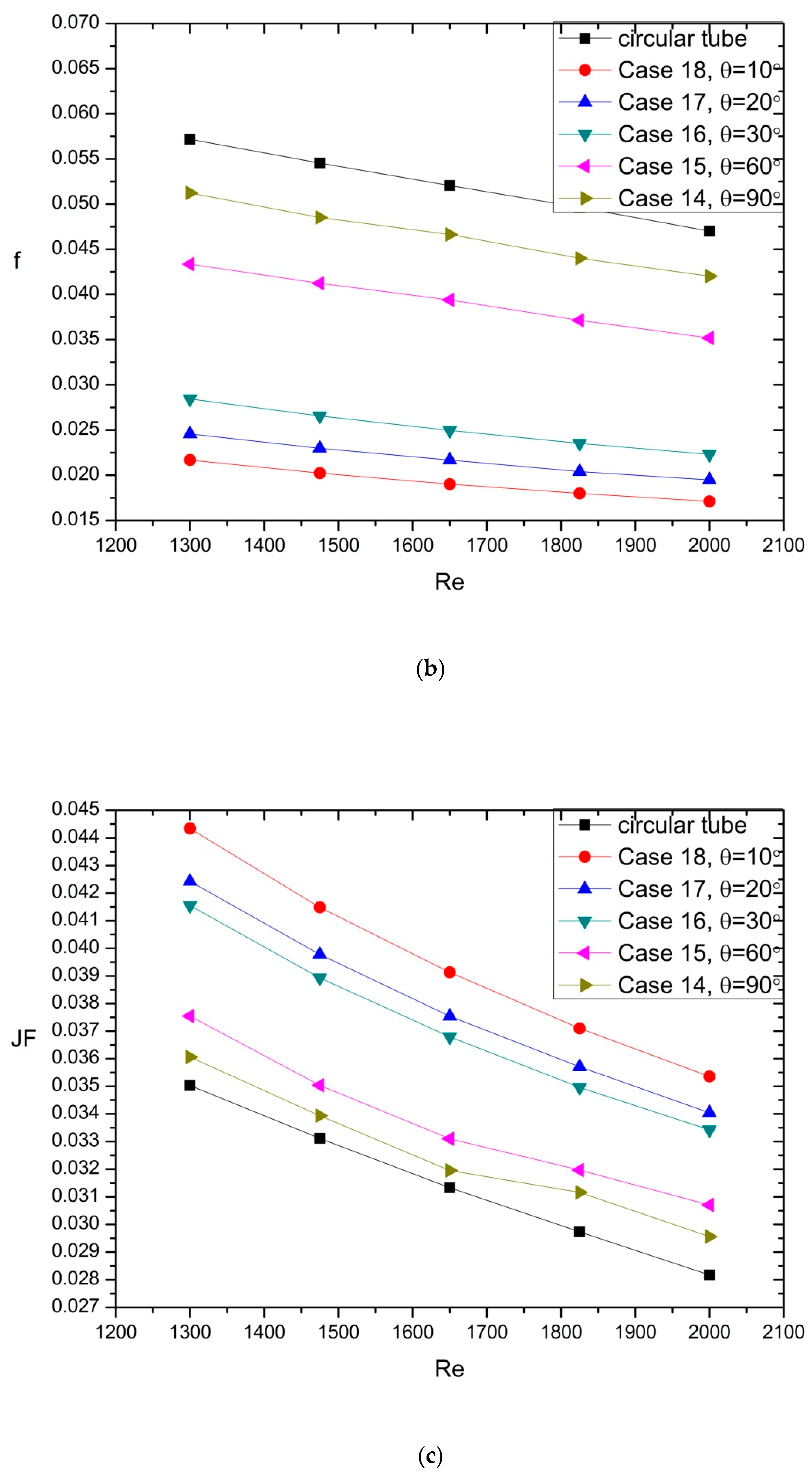
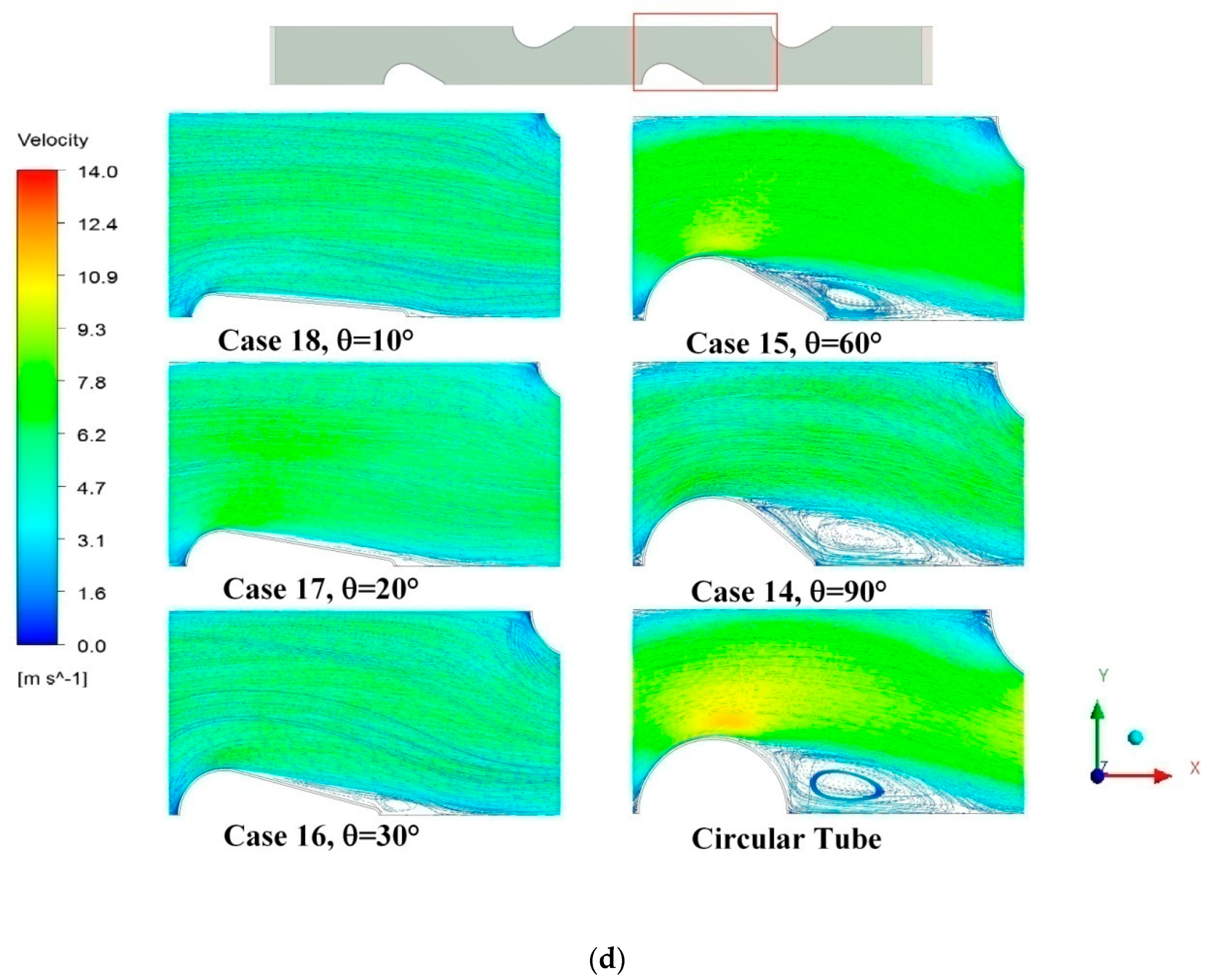
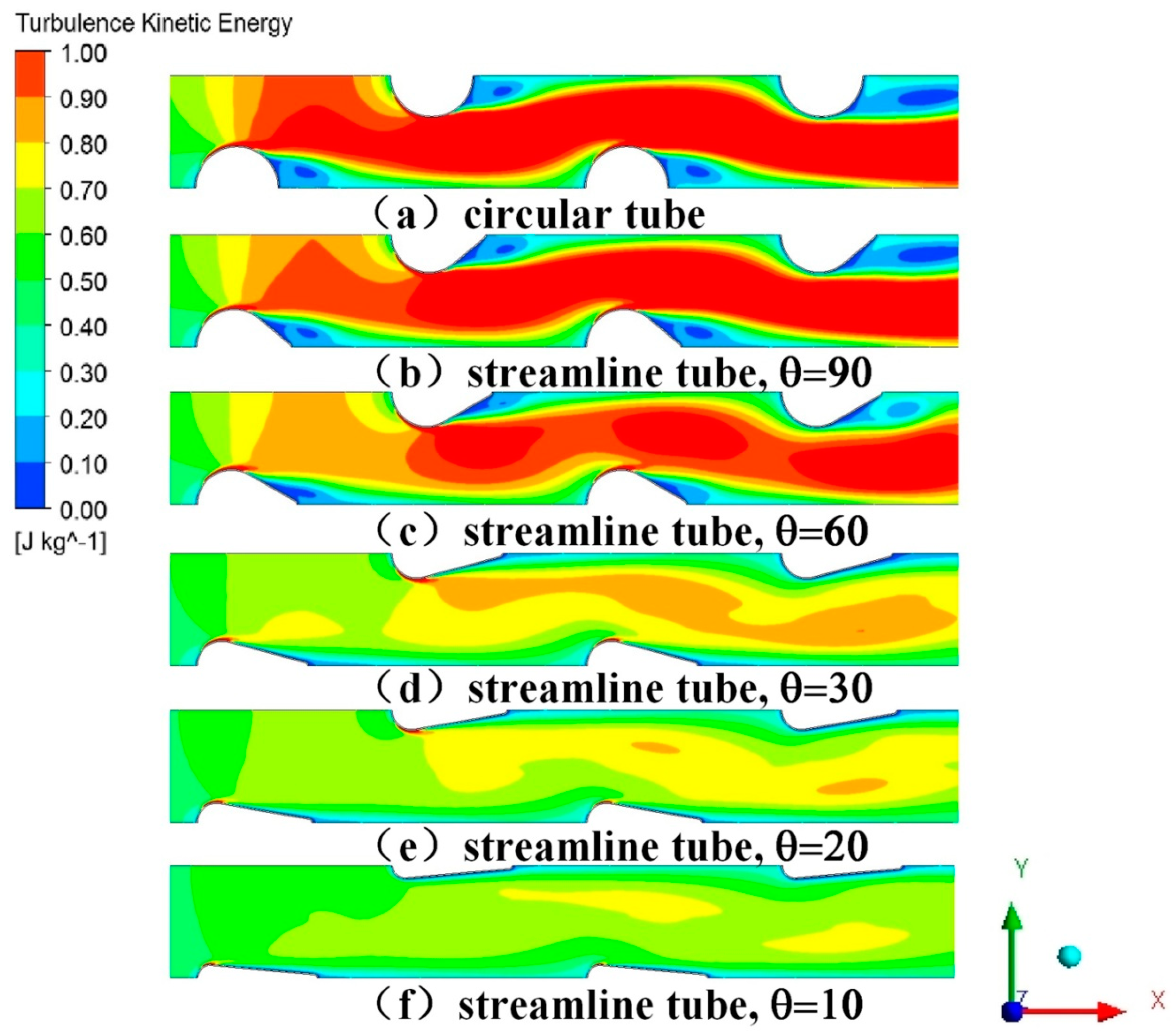
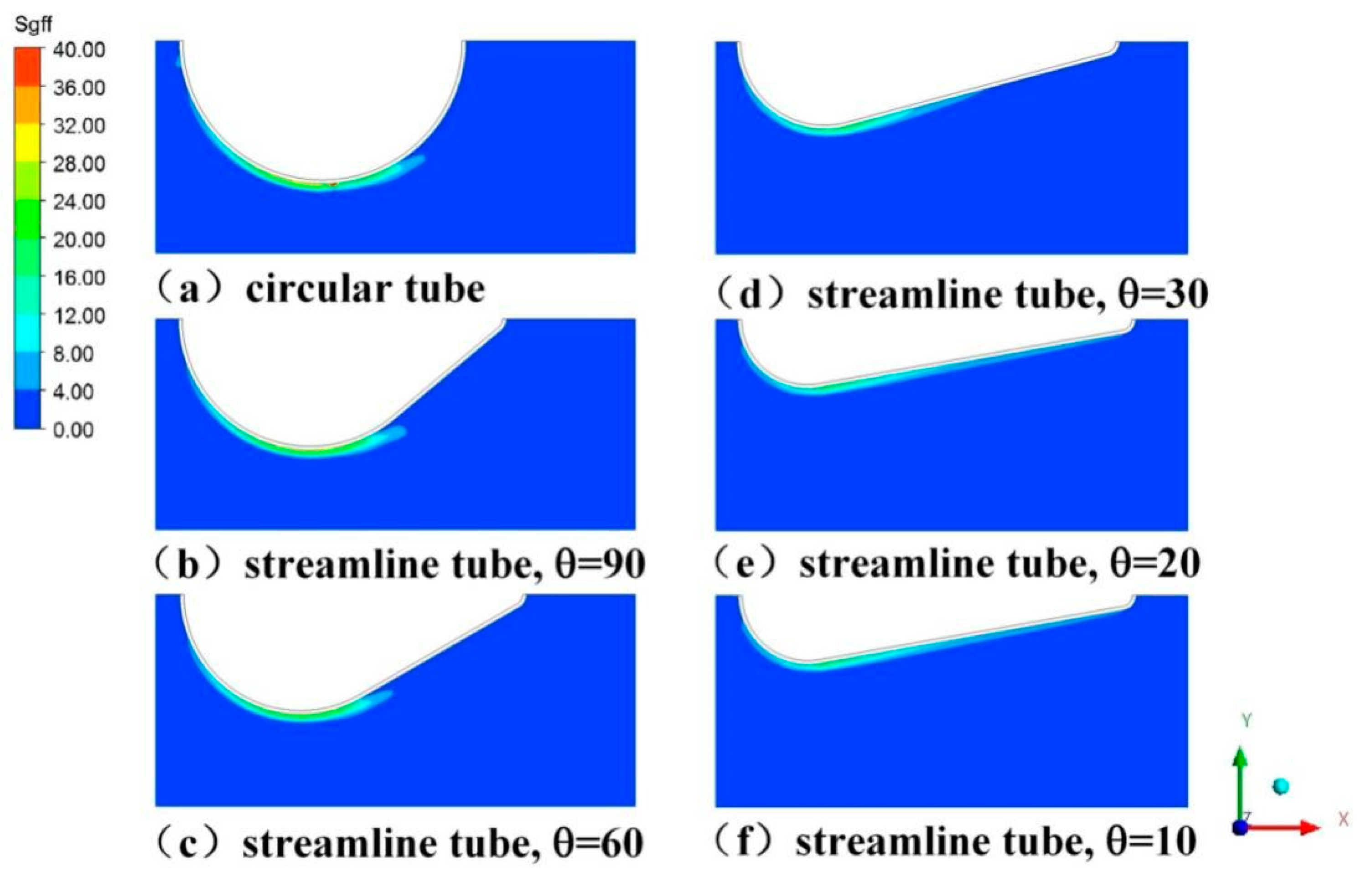
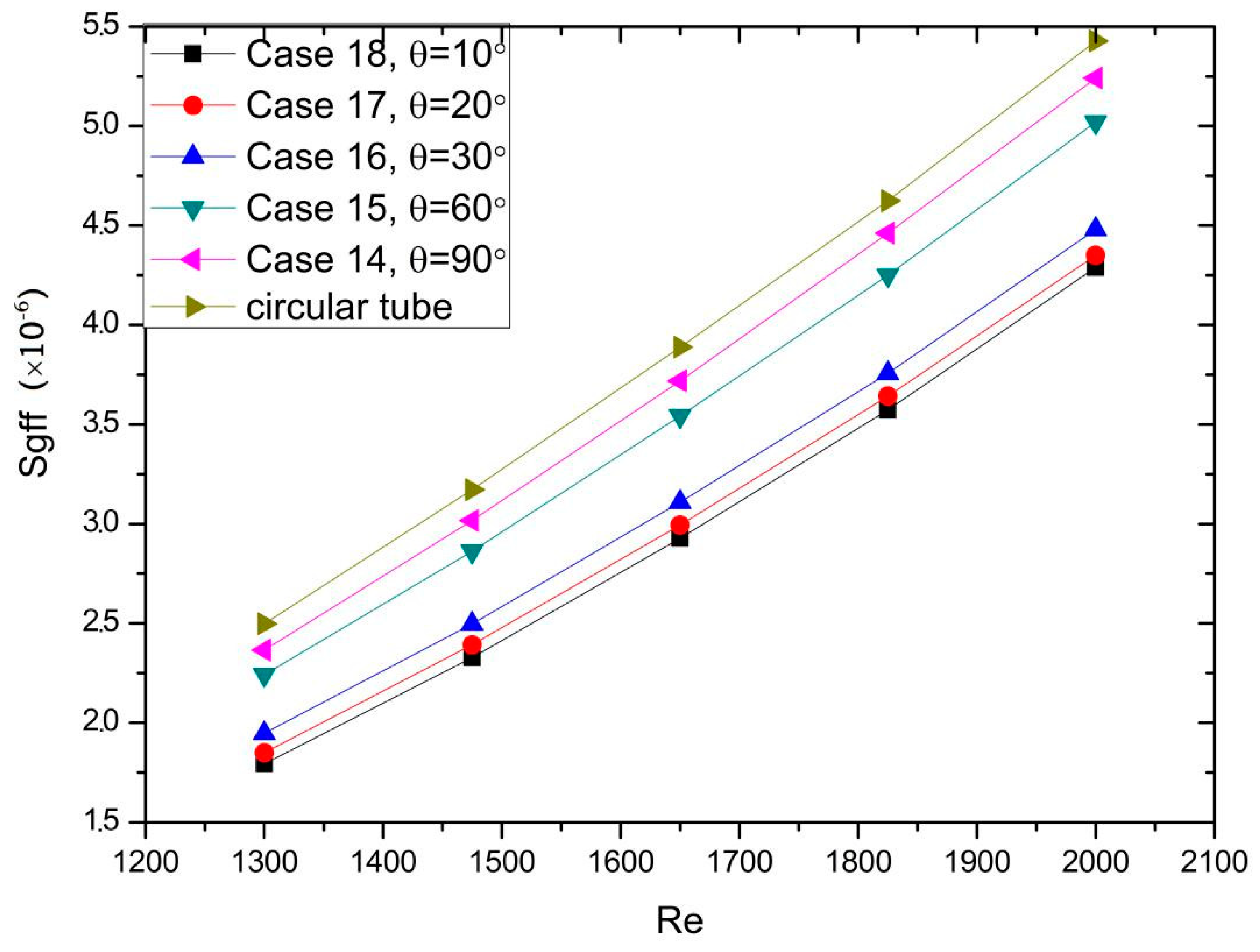
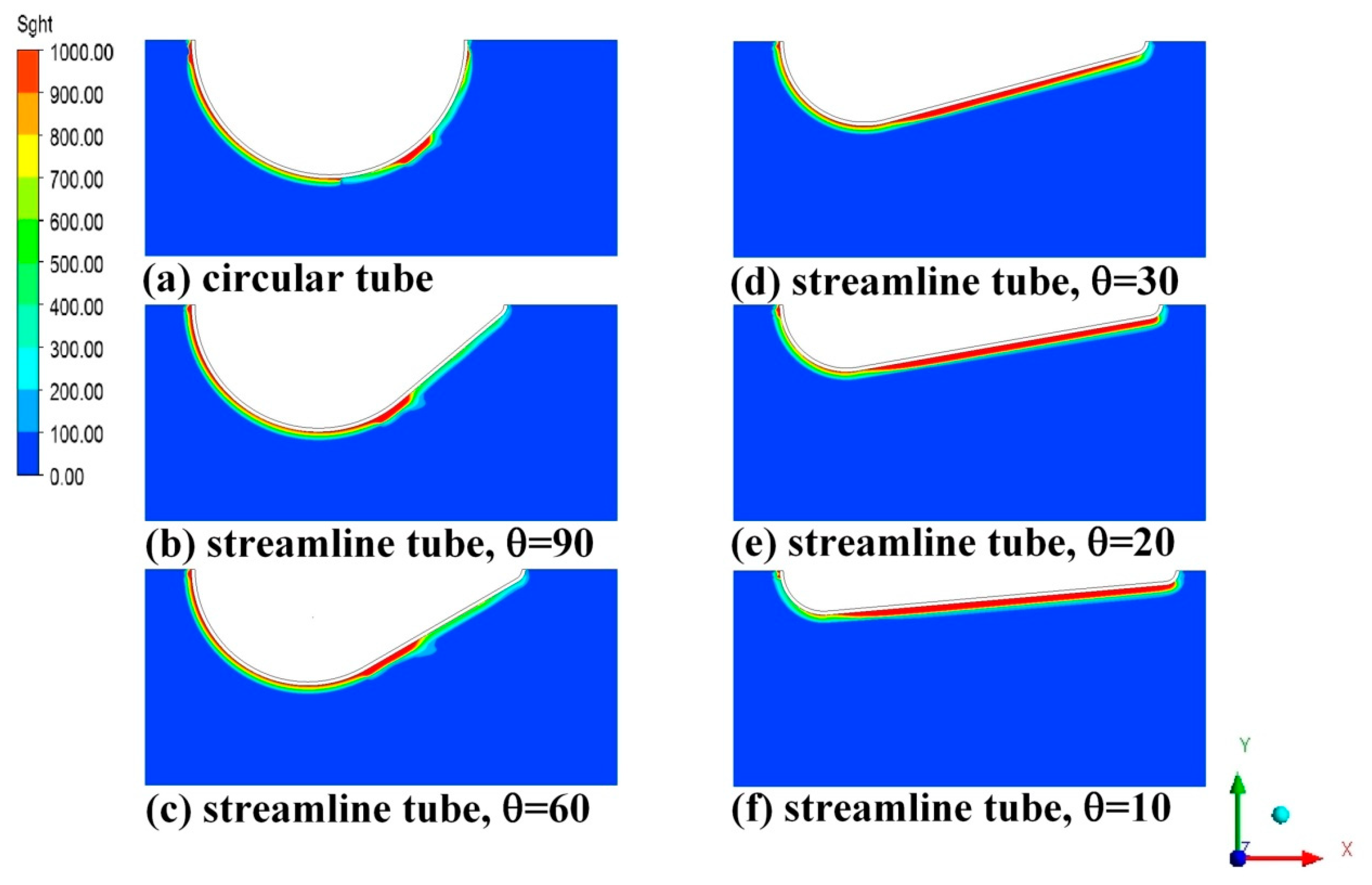
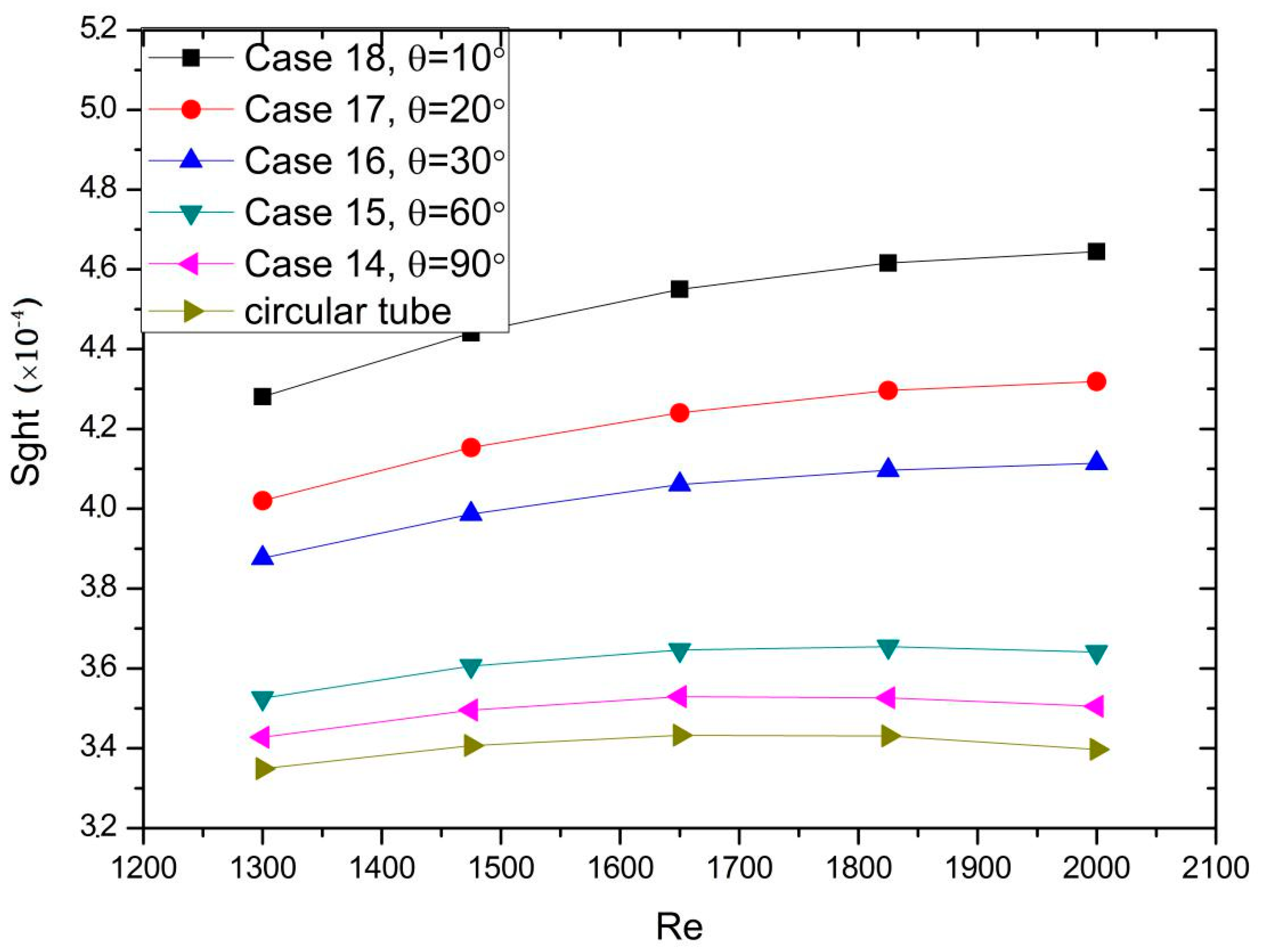
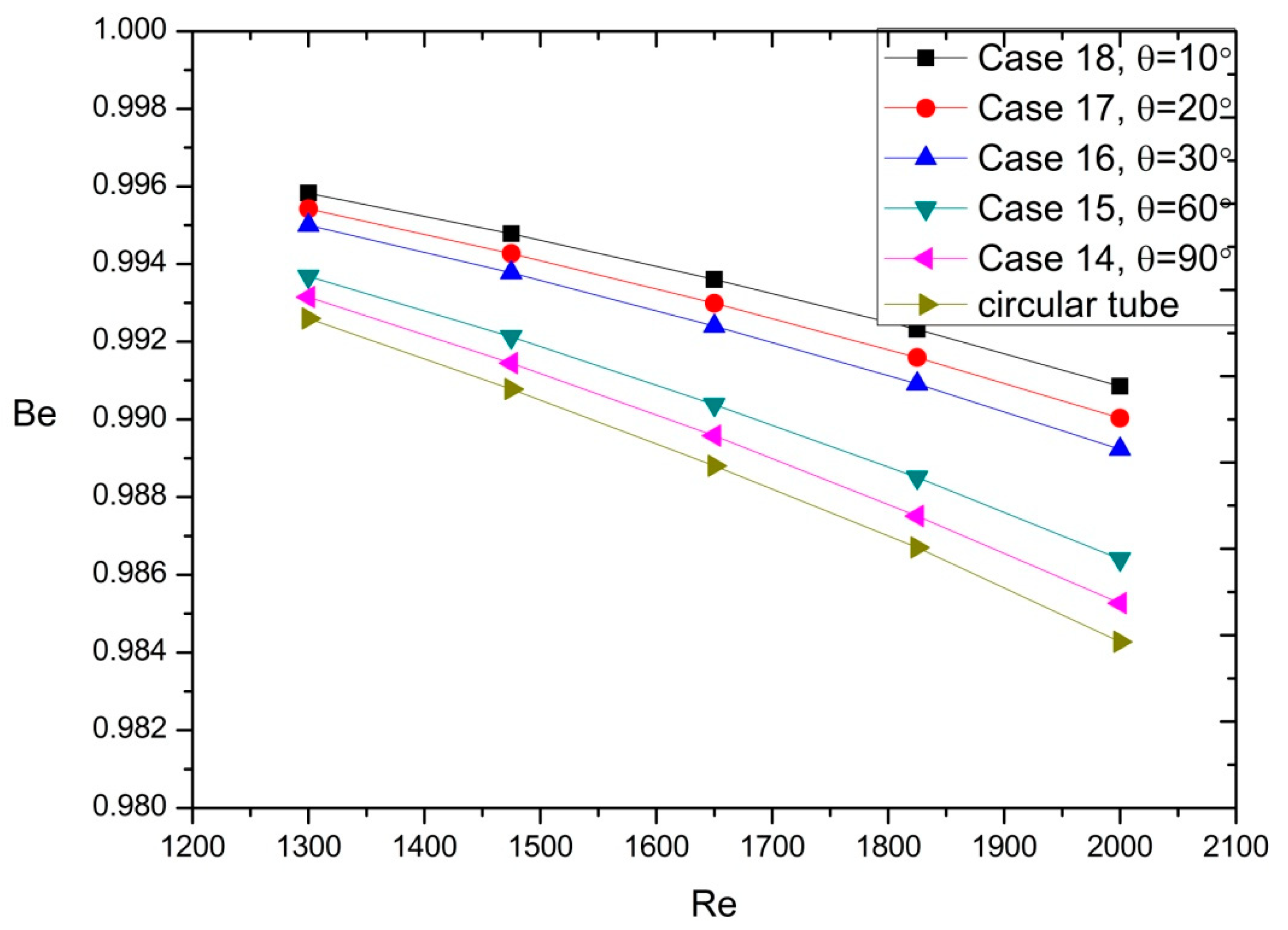
| Parameters | Value | |
|---|---|---|
| Circular Tube | Streamline Tube | |
| Tube outside radius (R) (mm) | 4.75 | 4.75 |
| The number of tube row () | 4 | 4 |
| Longitudinal tube pitch (Ll) (mm) | 22 | 22 |
| Transverse tube pitch (Lt) (mm) | 12.7 | 12.7 |
| Fin thickness (Ft) (mm) | 0.13 | 0.13 |
| Fin pitch (Fp) (mm) | 3 | 3 |
| VG angle () () | - | 60 |
| CASE No. | Ll (mm) | Lt (mm) | R (mm) | C (mm) | |
|---|---|---|---|---|---|
| Case1 | 22 | 21.4 | 60 | 3.99 | 29.85 |
| Case2 | 22 | 15.4 | 60 | 3.99 | 29.85 |
| Case3 | 22 | 17.4 | 60 | 3.99 | 29.85 |
| Case4 | 22 | 19.4 | 60 | 3.99 | 29.85 |
| Case5 | 22 | 23.4 | 60 | 3.99 | 29.85 |
| Case6 | 16 | 21.4 | 60 | 3.99 | 29.85 |
| Case7 | 18 | 21.4 | 60 | 3.99 | 29.85 |
| Case8 | 20 | 21.4 | 60 | 3.99 | 29.85 |
| Case9 | 24 | 21.4 | 60 | 3.99 | 29.85 |
| Case10 | 22 | 21.4 | 40 | 3.99 | 35.71 |
| Case11 | 22 | 21.4 | 50 | 3.99 | 32.11 |
| Case12 | 22 | 21.4 | 70 | 3.99 | 28.33 |
| Case13 | 22 | 21.4 | 80 | 3.99 | 27.29 |
| Case14 | 22 | 25.4 | 90 | 4.48 | 29.85 |
| Case15 | 22 | 25.4 | 60 | 3.99 | 29.85 |
| Case16 | 22 | 25.4 | 30 | 2.90 | 29.85 |
| Case17 | 22 | 25.4 | 20 | 2.30 | 29.85 |
| Case18 | 22 | 25.4 | 10 | 1.52 | 29.85 |
Publisher’s Note: MDPI stays neutral with regard to jurisdictional claims in published maps and institutional affiliations. |
© 2020 by the authors. Licensee MDPI, Basel, Switzerland. This article is an open access article distributed under the terms and conditions of the Creative Commons Attribution (CC BY) license (http://creativecommons.org/licenses/by/4.0/).
Share and Cite
Qian, Z.; Wang, Q.; Lv, S. Research on the Thermal Hydraulic Performance and Entropy Generation Characteristics of Finned Tube Heat Exchanger with Streamline Tube. Energies 2020, 13, 5408. https://doi.org/10.3390/en13205408
Qian Z, Wang Q, Lv S. Research on the Thermal Hydraulic Performance and Entropy Generation Characteristics of Finned Tube Heat Exchanger with Streamline Tube. Energies. 2020; 13(20):5408. https://doi.org/10.3390/en13205408
Chicago/Turabian StyleQian, Zuoqin, Qiang Wang, and Song Lv. 2020. "Research on the Thermal Hydraulic Performance and Entropy Generation Characteristics of Finned Tube Heat Exchanger with Streamline Tube" Energies 13, no. 20: 5408. https://doi.org/10.3390/en13205408
APA StyleQian, Z., Wang, Q., & Lv, S. (2020). Research on the Thermal Hydraulic Performance and Entropy Generation Characteristics of Finned Tube Heat Exchanger with Streamline Tube. Energies, 13(20), 5408. https://doi.org/10.3390/en13205408




